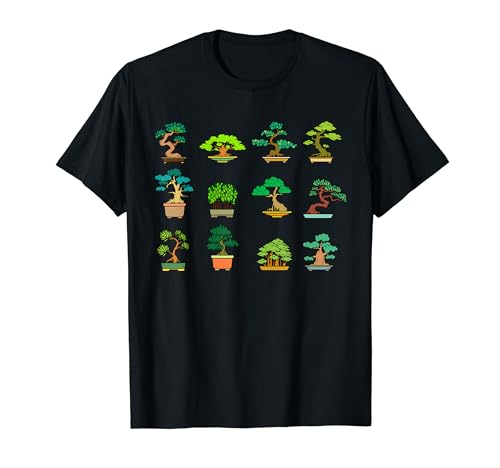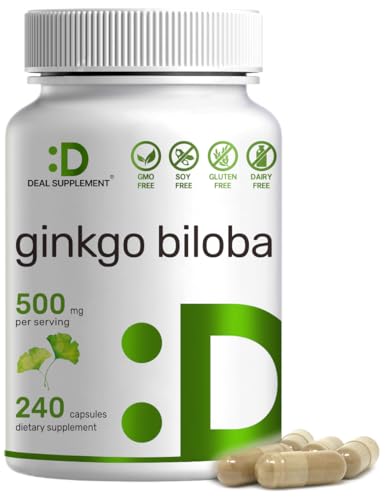Ginkgo biloba, commonly known as ginkgo or gingko ( GINK-oh, -goh) also known as the maidenhair tree, is a species of tree native to China. It is the only living species in the order Ginkgoales, which first appeared over 290 million years ago. Fossils very similar to the living species, belonging to the genus Ginkgo, extend back to the Middle Jurassic approximately 170 million years ago. The tree is widely cultivated, and was cultivated early in human history.
Contents
- 1 Description
- 2 Cultivation
- 3 Uses
- 4 Taxonomy
- 5 Products
- 5.1 Funny Bonsai Tree Whisperer Japanese Gardening Zen Gifts T-Shirt
- 5.2 Bronson Ginkgo Biloba Extra Supports Brain Function & Memory Support, 120 Vegetarian Capsules
- 5.3 Nutricost Ginkgo Biloba 120mg, 240 Capsules - Extra Strength Ginkgo Biloba Extract - Gluten Free & Non-GMO
- 5.4 Panax Ginseng and Ginkgo Biloba Complex Capsules with Korean Red Ginseng & Ginko Leaf Extract Supplement for Men & Women - Supports Memory Focus Energy & Brain Function - Vegan Pills - 120ct
- 5.5 Nature's Bounty Ginkgo Biloba Capsules 120mg, Memory Support Supplement, Supports Brain Function and Mental Alertness, 100 Capsules
- 5.6 NOW Supplements, Ginkgo Biloba 120 mg, Double Strength, Non-GMO Project Verified, 200 Veg Capsules
- 5.7 Doctor's Best Extra Strength Ginkgo, Non-GMO, Gluten Free, Vegan, Soy Free, Promotes Mental Function and Memory, 120 mg, 120 Count (Pack of 1)
- 5.8 Herbal Roots Ginkgo Biloba Made with Pure Organic Ginkgo Leaf - 1,400mg per Serving, 60 Vegan Capsules
- 5.9 Ginkgo Biloba 500mg Per Serving, 5 Month Supply – Grown in Northern Asia – Extra Strength, Non-GMO, No Gluten
- 5.10 Nature's Bounty Ginkgo Biloba 60 Mg, 200 Capsules (17243)
Description
Ginkgos are large trees, normally reaching a height of 20-35 m (66-115 ft), with some specimens in China being over 50 m (165 ft). The tree has an angular crown and long, somewhat erratic branches, and is usually deep rooted and resistant to wind and snow damage. The crown grows wider as the tree age, becoming taller and more slender. During autumn, the leaves turn a bright yellow, then fall, sometimes within a short space of time (one to 15 days). Ginkgos are long-lived because of their resistance to diseases, insect-resistant wood, and ability to form aerial roots or sprouts. Some specimens have been estimated to live up to 2,500 years.
Leaves
The leaves are unique among seed plants, being fan-shaped with veins radiating out into the leaf blade, sometimes bifurcating (splitting), but never anastomosing to form a network. This is called dichotomous veneation, where two veins enter the leaf blade’s base and then fork in two. The leaves are usually 5-10 cm (2-4 in), but sometimes up to 15 cm (6 in) long. The old popular name “maidenhair tree” is because the leaves resemble some of the pinnae of the maidenhair fern, Adiantum capillus-veneris. Ginkgos are prized for their autumn foliage, which is a deep saffron yellow.
Leaves of long shoots are usually notched or lobed, but only from the outer surface, between the veins. They are borne both on the more rapidly growing branch tips, where they are alternate and spaced out, and also on the short, stubby spur shoots, where they are clustered at the tips. Leaves are green both on the top and bottom and have stomata on both sides.
Branches
Ginkgo branches grow in length by growth of shoots with regularly spaced leaves, as seen on most trees. Short shoots, also known as spur shoots, are formed from the axils and second-year growth. They have very small internodes, so they can grow just one to two centimeters per year. Their leaves are also usually not lobed. They are small and knobby and are placed on branches regularly, except for the first year. Because of the short internodes, leaves appear to be clustered at the tips of short shoots, and reproductive structures are formed only on them (see pictures below – seeds and leaves are visible on short shoots). In ginkgos, as in other plants that possess them, short shoots allow the formation of new leaves in the older parts of the crown. After a number of years, a short shoot may change into a long (ordinary) shoot, or vice versa.[citation needed]
Ginkgo prefers full sun and grows best in environments that are well-watered and well-drained. The species shows a preference for disturbed sites; in the “semiwild” stands at Tianmu Mountains, many specimens are found along stream banks, rocky slopes, and cliff edges. Accordingly, ginkgo retains a prodigious capacity for vegetative growth. In response to soil erosion, it can sprout from embedded buds at the trunk’s base (lignotubers or basal Chichi). In response to disturbances like crown damage, old individuals can also produce aerial roots under large branches. These roots can be used to clone the soil. These strategies are evidently important in the persistence of ginkgo; in a survey of the “semiwild” stands remaining in Tianmushan, 40% of the specimens surveyed were multistemmed, and few saplings were present.:86-87
Reproduction
Ginkgo biloba is dioecious, with separate sexes, some trees being female and others being male. Male plants produce small pollen cones with sporophylls, each bearing two microsporangia spirally arranged around a central axis.
Cones are not produced by female plants. The stalk ends with two ovules. After pollination, either one or both of them become seeds. The seed is 1.5-2 cm long. Its fleshy outer layer (the sarcotesta) is light yellow-brown, soft, and fruit-like. It is attractive in appearance, but contains butyric acid (also known as butanoic acid) and smells like rancid butter or vomit when fallen. The sarcotesta contains the hard sclerotesta, the “shell” of the seeds, and a papery Endotesta with the nucellus around the female gametophyte in the middle.
The fertilization of ginkgo seeds occurs via motile sperm, as in cycads, ferns, mosses and algae. The sperm is large, measuring between 70 and 90 micrometres. They are comparable to the sperm from cycads which are slightly larger. Ginkgo sperm were first discovered by the Japanese botanist Sakugoro Hirase in 1896. The sperm have a complex multi-layered structure, which is a continuous belt of basal bodies that form the base of several thousand flagella which actually have a cilia-like motion. The flagella/cilia apparatus pulls sperm’s body forwards. The sperm have only a tiny distance to travel to the archegonia, of which there are usually two or three. There are two sperm produced. One of these sperm successfully fertilizes an ovule. Although it is widely held that fertilization of ginkgo seeds occurs just before or after they fall in early autumn, embryos ordinarily occur in seeds just before and after they drop from the tree.
Genome
Chinese scientists published a draft genome of Ginkgo biloba in 2016. The tree has a large genome of 10.6 billion DNA nucleobase “letters” (the human genome has three billion) and about 41,840 predicted genes which enable a considerable number of antibacterial and chemical defense mechanisms.
A 2020 study of gingko trees aged up to 667 years in China found that there were no signs of aging. The trees also continued to grow and produce immuno-defense chemicals throughout their lives.
Phytochemicals
Extracts of ginkgo leaves contain phenolic acids, proanthocyanidins, flavonoid glycosides, such as myricetin, kaempferol, isorhamnetin and quercetin, and the terpene trilactones, ginkgolides and bilobalides. The leaves also contain unique ginkgo biflavones, as well as alkylphenols and polyprenols.
Cultivation
Ginkgo has long been cultivated in China. It is found in the country’s southern third. Some planted trees at temples are believed to be over 1,500 years old. The first record of Europeans encountering it is in 1690 in Japanese temple gardens, where the tree was seen by the German botanist Engelbert Kaempfer. Because of its status in Buddhism and Confucianism, the ginkgo is also widely planted in Korea and in Japan since the 14th century; in both areas, some naturalization has occurred, with ginkgos seeding into natural forests. Gingko has been commonly cultivated in North America for over 200 years and in Europe for close to 300, but during that time, it has never become significantly naturalized.
Intentionally planted ginkgos are male cultivars that have been grafted onto seeds from plants. The male trees won’t produce the malodorous seedlings. The popular cultivar ‘Autumn Gold’ is a clone of a male plant.
The disadvantage of male Ginkgo biloba trees is that they are highly allergenic. They have an OPALS allergy scale rating of 7 (out of 10), whereas female trees, which can produce no pollen, have an OPALS allergy scale rating of 2.
Female cultivars include ‘Liberty Splendor’, ‘Santa Cruz’, and ‘Golden Girl’, the latter so named because of the striking yellow color of its leaves in the fall; all female cultivars release zero pollen.
Many cultivars are listed in the literature in the UK, of which the compact ‘Troll’ has gained the Royal Horticultural Society’s Award of Garden Merit.
Ginkgos are able to adapt to urban environments, despite being exposed to pollution and having to live in tight spaces. They rarely suffer disease problems, even in urban conditions, and are attacked by few insects.
Ginkgos are popular subjects for growing as miniature landscapes known as penjing and bonsai; they can be kept artificially small and tended over centuries. The trees are easy to propagate from seed.
Hiroshima
Extreme examples of the ginkgo’s tenacity may be seen in Hiroshima, Japan, where six trees growing between
1-2 kilometres (1/2–1+1/4 miles) from the 1945 atom bomb explosion were among the few living things in the area to survive the blast. The ginkgos survived the blast and survived, even though they were charred.
The six trees are still alive: They are marked with signs at Housenbou (Bao Zhuan Fang ) temple (planted in 1850), Shukkei-en (planted about 1740), Josei-ji (planted 1900), at the former site of Senda Elementary School near Miyukibashi, at the Myojoin temple, and an Edo period-cutting at Anraku-ji temple.
1000-year-old ginkgo at Tsurugaoka Hachimangu
The ginkgo tree that stood next to Tsurugaoka Hachiman-gu’s stone stairway approximately from the Shinto shrine’s foundation in 1063, and which appears in almost every old depiction of the shrine, was blown down on 10 March 2010. The remaining roots of the tree were later seen to be sprouting vigorously. The shrine can be found in Kamakura, Kanagawa Prefecture Japan.
The tree was called kakure-icho (“hiding ginkgo”) after an Edo period legend that Minamoto no Sanetomo was assassinated by Kugyo, his nephew. He had been hiding behind it. In fact ginkgos arrived from China in the 14th century, and a 1990 tree-ring measurement indicated the tree’s age to be about 500 years.
Uses
Culinary
The nut-like gametophytes inside the seeds are particularly esteemed in Asia, and are a traditional Chinese food. Ginkgo nuts can be used in congee and are often served as part of the vegetarian dish Buddha’s delight. Ginkgo seeds are added to Japanese dishes (called Ginnan). Cooked seeds are often eaten with other dishes.
When eaten in large quantities or over a long period, the gametophyte (meat) of the seed can cause poisoning by 4′-O-methylpyridoxine (MPN). MPN is heat-stable, and cannot be destroyed by cooking. MPN convulsions can be treated with pyridoxine (vitamin A6), according to studies.
Some people are sensitive to the chemicals in the sarcotesta, the outer fleshy coating. They should use disposable gloves when handling the seeds. The symptoms are allergic contact dermatitis or blisters similar to that caused by contact with poison ivy.
Medical research
Although extracts of Ginkgo biloba leaf are often marketed as cognitive enhancers, there is no evidence for effects on memory or attention.
Systematic reviews have shown there is no evidence for effectiveness of ginkgo in treating high blood pressure, menopause-related cognitive decline, tinnitus, post-stroke recovery, or altitude sickness. One review showed weak preliminary evidence for gingko affecting dementia.
Adverse effects
The use of Ginkgo biloba leaf extracts may have undesirable effects, especially in terms of drug interactions. Gingko pollen may produce allergic reactions.
Those at risk include individuals with blood circulation disorders[citation needed] and those taking anticoagulants, such as warfarin or antiplatelet medication,[better source needed] although studies have found ginkgo has little or no effect on the anticoagulant properties or pharmacodynamics of warfarin in healthy subjects. Additional side effects include increased risk of bleeding, gastrointestinal discomfort, nausea, vomiting, diarrhea, headaches, dizziness, heart palpitations, and restlessness.
According to a systemic review, the effects of ginkgo on pregnant women may include increased bleeding time, and there is inadequate information about safety during lactation.
Ginkgo biloba leaves and sarcotesta also contain ginkgolic acids, which are highly allergenic, long-chain alkylphenols such as bilobol or adipostatin A (bilobol is a substance related to anacardic acid from cashew nut shells and urushiols present in poison ivy and other Toxicodendron spp.) Individuals with a history of strong allergic reactions to poison ivy, mangoes, cashews and other alkylphenol-producing plants are more likely to experience allergic reaction when consuming non-standardized ginkgo-containing preparations, combinations, or extracts thereof. These allergens were limited to 5 ppm in standard pharmaceutical preparations Ginkgo Biloba by the Commission E, the former Federal German Health Authority. Overconsumption of seeds from Gingko biloba can deplete vitamin B6.
Traditional medicine
Ginkgo has been used in traditional Chinese medicine since at least the 11th century C.E. Ginkgo leaves, seeds, and nuts have been traditionally used to treat a variety of ailments, including dementia, asthma, bronchitis and kidney and bladder problems. However, there is no conclusive evidence that ginkgo is helpful for these conditions.
After serious conditions had been excluded, the European Medicines Agency Committee on Herbal Medicinal Products ruled that mild age-related dementia can be treated with ginkgo leaves.
Taxonomy
The older Chinese name for this plant is Yin Guo , meaning “silver fruit”, pronounced yinguo in Mandarin or Ngan-gwo in Cantonese. The current commonly used names are Bai Guo (bai guo), meaning “white fruit”, and Yin Xing (yinxing), meaning “silver apricot”. The name Yin Xing was borrowed in Japanese ichiyou (ichou) or ginnan (ginnan) and Korean eunhaeng (eunhaeng), when the tree was introduced from China.
Carl Linnaeus described the species in 1771, the specific epithet biloba derived from the Latin bis, “twice” and loba, “lobed”, referring to the shape of the leaves. Two names for the species recognise the botanist Richard Salisbury, a placement by Nelson as Pterophyllus salisburiensis and the earlier Salisburia adiantifolia proposed by James Edward Smith. The epithet of the latter may have been intended to denote a characteristic resembling Adiantum, the genus of maidenhair ferns.
The scientific name Ginkgo is the result of a spelling error that occurred three centuries ago. Kanji typically have multiple pronunciations in Japanese, and the characters Yin Xing used for ginnan can also be pronounced ginkyo. Engelbert Kaempfer was the first Westerner who investigated the species in 1690. He recorded this pronunciation in his notes for the Amoenitates Exoticae (1712). The “awkward spelling” “ginkgo” was used. This appears to be a simple error of Kaempfer; taking his spelling of other Japanese words containing the syllable “kyo” into account, a more precise romanization following his writing habits would have been “ginkio” or “ginkjo”. Linnaeus, who relied on Kaempfer when dealing with Japanese plants, adopted the spelling given in Kaempfer’s “Flora Japonica” (Amoenitates Exoticae, p. 811). Kaempfer’s drawing can be found in Hori’s article.
Classification
The relationship of ginkgo to other plant groups remains uncertain. Although it has been loosely placed in the divisions Spermatophyta or Pinophyta there has not been a consensus. Since its seeds are not protected by an ovary wall, it can morphologically be considered a gymnosperm. Technically, the apricot-like structures made by female ginkgo tree trees are not fruits. However, they are seeds with a shell that consists of a soft and fleshy (the Sarcotesta) and a harder (the Sclerotesta). The sarcotesta has a strong smell that most people find unpleasant.
The ginkgo is classified in its own division, the Ginkgophyta, comprising the single class Ginkgoopsida, order Ginkgoales, family Ginkgoaceae, genus Ginkgo and is the only extant species within this group. It is one of the best-known examples of a living fossil, because Ginkgoales other than G. biloba are not known from the fossil record after the Pliocene.
Last update on 2022-01-29. Price and availability of products may change.










